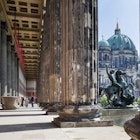
Nov 19, 2024 • 4 min read

Dec 9, 2020 • 7 min read

Outdoor swimming at Frauenbad Stadthausquai in Zurich, Switzerland © Alessandro Della Bella
Cold-water swimming has hit the headlines in recent years – it boosts the immune system; builds resilience; helps with depression – but can pools also show travelers a different side to a city? Writer Christopher Beanland thinks so. He’s visited more than 50 outdoor pools across the world for his new book Lido: A dip into outdoor swimming pools: the history, design and people behind them, showing us that public pools can reveal more about a place than we might realise.

It’s dawn. Perhaps pre-dawn. Still cold, dawn. The sun slowly rises from somewhere, its glow is backlighting the nearby tower blocks, but it itself remains out of sight. The early bird is not yet up, the worm is slumbering too. But here, in this leafy, quiet corner of East London, steam rises from the glassy, undisturbed water of London Fields Lido as the morning’s first swimmers – hardy, swim-capped regulars in goggles – slowly lower themselves into the pool, breaking its tranquil spell, to begin restorative lengths between the red lane ropes.
These are the swimmers you read about in the wellness pages: the ritualistic, first-light bathers. The ones who set their alarm clocks before the trash collectors and live for over 100 years because they complete 20 lengths of the local outdoor pool each morning. Far from the madding Boxing Day dip crowd, they are seasoned splashers who have been transformed by open-air swimming, reinvigorated by the calm of a capital before its coffee shops open.

Christopher Beanland is not one of those swimmers. He’s obsessed, of course, as anyone who’s made the conscious decision to travel to the most intriguing outdoor swimming pools in the world would be, but – to paraphrase him a little more politely than he says on record – he’s not really a morning person. “Some people do it at 6am,” says Christopher, “I normally go there on my lunch break.”
Each day he's in London, Christopher typically ticks off 20 lengths of London Fields Lido – reputedly “Britain’s most hipster,” as anything northeast of the Barbican usually is – and he can be easily spotted by his bright pink swim shorts and Wayfarer sunglasses. But on vacation, Christopher will seek out the nearest outdoor pool too.
It was this habitual holiday swim that gave him the idea for Lido, his wonderful rumination on the architecture, art and philosophy behind swimming and outdoor pools. "There's interesting pools in different cities, both architecturally and historically," says Christopher about the book, “and I thought it would actually be interesting to tell their stories.” It also gave him the perfect excuse to don his goggles.
Gliding effortlessly between The Great Bath at Mohenjo-daro in Pakistan, a 5000-year-old public pool believed to be the world’s first, to London’s Swim Dem Crew who are trying to encourage more swimmers of color into the water, the book is filled with absorbing anecdotes and architectural insight. Its wistful photography will give you the urge to divebomb right in.

“Lidos are architecture you can use: you're actually getting in there and you're a part of it,” says Christopher, who believes local pools add to the experiential side of travel. “It's a more visceral way to experience a place – it makes your travel experience much more intense.”
He cites his trip to the pool at Zollverein Coal Mine in Essen, Germany as an example. When this former colliery and cokery was decommissioned, it was transformed into a huge complex that celebrated its history rather than being demolished completely. It now houses a museum, an art center, several restaurants and a pool. And a damn cool pool at that.
The makeover, Christopher writes in Lido, is an “interesting lesson in industry and memory,” and from an aesthetics standpoint, it's a wonderfully playful example of industrial regeneration. The 12m-long pool, created by Frankfurt artists Dirk Paschke and Daniel Milohnic, sits where coal was baked into coke; the blast furnaces, colorful pipes, the exposed red staircases all remain in their original places. By using the lido, swimmers are, in essence, interacting directly with history.
“The way we travel now – and I think it is fuelled by Instagram – people want to see photos of someone in this iconic place and they want to go there and get a photo of them enjoying this thing too,” says Christoper. This isn’t, he insists, a Bad Thing. “Whenever I look at people traveling on Insta, they want to climb up the mountain and they want to swim in the lake,” he says. “Whereas in the past – and I've been guilty of this – we’d maybe just go and look at those things.”
Take the iconic photographs of the diving at the Barcelona 1992 Olympics, perhaps the Games’ most defining imagery: shots of divers leaping from the springboard, twisting and contorting in the air, with La Sagrada Família rising above the rooftops in the background. That pool, Piscina Municipal de Montjuïc, is open to the public from July to September, so travelers can, if they’re brave enough, dive in themselves.

Lidos also give travelers a unique take on a city, one from a local perspective. “I think it's increasingly something that you're going to find in travel guides,” Christopher says. “Places like the Oasis Sports Centre in Holborn are probably not in any London travel guides, even though it's like a really interesting place: an open-air pool right in the middle of London.”
Built atop a natural spring, the Oasis was a Turkish bath in the early 1700s, one that supposedly counted Queen Anne among its patrons. Now it’s an intriguing pool dwarfed by flats and high-rise office blocks and a blink-and-you’ll-miss-it entrance. But thanks to a resurgence in popularity, lidos like this may well find themselves into guidebooks.
“A swimming pool renaissance is underway,” says Christopher, who visited a number of pools that have had new life breathed into them. This included Saltdean Lido in Brighton, “England best looking”, and the remarkable Piscine Molitor, Paris’ art deco stunner where the bikini was first debuted in 1946.

But others, like the North Sydney Olympic Pool in Australia, which sits beneath the shadow of the Sydney Harbour Bridge, and the famous wave-smashed Bondi Icebergs Pool on Bondi Beach, have remained perennially popular.
Front crawl across the Atlantic and the tide is changing there too. The Neptune Pool at Hearst Castle in California is a wonderfully gauche homage to the ancient civilizations of Europe. Built for the newspaper magnate William Randolph Hearst in 1924, it features a Vermont marble pool surrounded by Greek and Roman temples with colonnades and Cassou statues as well as a sculpture of Neptune. “Gaudy, isn’t it?” says Christopher.
Having been repaired and refilled in 2018, the pool opened to the public for the first time in July 2019. It costs US$1250 to enter – yes, you read that correctly – but what makes this pool so interesting is that it was designed by Julia Morgan, California's first female architect.
When Morgan traveled to France to study at École des Beaux-Arts in Paris in 1896, she was initially refused admission because the school had never before admitted a woman. It took another two years before Morgan was permitted entry, and Neptune Pool now forms part of her little-known legacy.
“There’s so many great stories,” says Christopher, “but one of my favorites is from Australia where I discovered a blue plaque at the Bronte Rock Pool dedicated to Evelyn Whillier.” After competing as a swimmer at the 1936 Berlin Olympics, and then winning gold, silver and bronze medals at the 1938 Empire Games, Whillier dedicated the next 46 years of her life to teaching children to swim at this free pool, which is cut dramatically into the cliff.
And it’s stories like that, which remind us as to why so many lidos exist. "Britain's lidos were mostly built in 1920 and 1930s. In that period, people thought it was really important to learn to swim and also have these community places where people could go and exercise and get fresh air,” explains Christopher. “So it's part of a whole movement like social housing, the NHS, and all these ideas of improving people’s lives."
London Fields Lido was built in 1932 as part of an egalitarian drive to improve public health, but the pool was closed in 1988 when its funding was cut by the government. After some fierce campaigning, it reopened in 2006 and now more than 250,000 people swim at the pool annually – Christopher included.
“The lidos that have simply provided their community service are getting their dues,” he says. “[They offer] redemption for the price of a coffee.”
Lido: A dip into outdoor swimming pools: the history, design and people behind them by Christopher Beanland is published by Batsford.
Wild swimming in the city: 7 urban breaks to dive into
Lonely Planet's latest book explores the world's most beautiful swimming holes, lakes, coves and more
Where to cool off with an unforgettable wild swim


Nov 19, 2024 • 4 min read

Nov 7, 2024 • 6 min read

Nov 6, 2024 • 7 min read




Oct 31, 2024 • 11 min read


Oct 31, 2024 • 5 min read